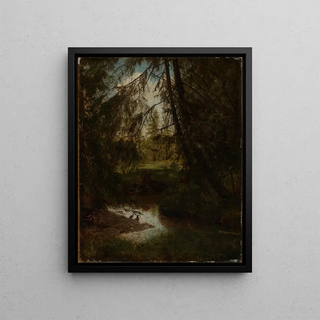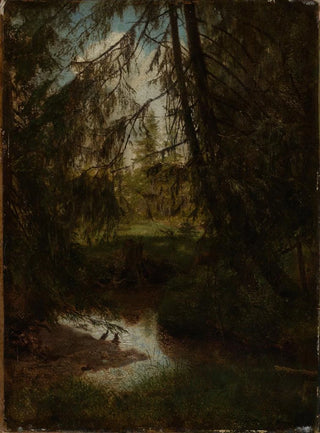Art print | Pines by the forest stream - Hans Thoma


View from behind

Frame (optional)
In the world of art, some works manage to capture the very essence of nature, evoking a deep connection with our environment. "Sapins au bord du ruisseau forestier - Hans Thoma" is one of these works. Painted at the end of the 19th century, it invites the viewer to immerse themselves in a landscape filled with serenity and mystery. Through this canvas, Thoma transports us to the heart of a lush forest, where majestic fir trees stand proudly, bearing witness to the timeless beauty of nature. The light filtering through the branches creates a play of shadows and highlights, offering an almost magical atmosphere where time seems to stand still. This work does not merely depict a landscape; it evokes a sensory experience, a call to contemplation.
Style and uniqueness of the work
Hans Thoma's style is characterized by a realistic approach, but with a touch of idealism that magnifies the subject. In "Sapins au bord du ruisseau forestier," he succeeds in combining precision and poetry. The details of the trees, leaves, and water are rendered with meticulous care, reflecting his attentive observation of nature. However, this realism is tempered by a palette of vibrant colors, where the deep greens of the firs blend with the shimmering nuances of the sky and water. This chromatic harmony creates a soothing, almost dreamlike atmosphere. Thoma also plays with perspective, guiding the viewer's gaze across the painting, as an invitation to explore this enchanting landscape. Thus, each element of the composition contributes to creating a sense of balance and tranquility, making this work a true hymn to nature.
The artist and his influence
Hans Thoma, born in 1839 in Germany, is often regarded as one of the pioneers of the naturalist movement. His work is marked by a profound admiration for nature and a desire to depict it in all its splendor. Influenced by landscape masters, Thoma developed a personal style that combines tradition and innovation. He was also a passionate advocate for German art, seeking to

Matte finish

View from behind

Frame (optional)
In the world of art, some works manage to capture the very essence of nature, evoking a deep connection with our environment. "Sapins au bord du ruisseau forestier - Hans Thoma" is one of these works. Painted at the end of the 19th century, it invites the viewer to immerse themselves in a landscape filled with serenity and mystery. Through this canvas, Thoma transports us to the heart of a lush forest, where majestic fir trees stand proudly, bearing witness to the timeless beauty of nature. The light filtering through the branches creates a play of shadows and highlights, offering an almost magical atmosphere where time seems to stand still. This work does not merely depict a landscape; it evokes a sensory experience, a call to contemplation.
Style and uniqueness of the work
Hans Thoma's style is characterized by a realistic approach, but with a touch of idealism that magnifies the subject. In "Sapins au bord du ruisseau forestier," he succeeds in combining precision and poetry. The details of the trees, leaves, and water are rendered with meticulous care, reflecting his attentive observation of nature. However, this realism is tempered by a palette of vibrant colors, where the deep greens of the firs blend with the shimmering nuances of the sky and water. This chromatic harmony creates a soothing, almost dreamlike atmosphere. Thoma also plays with perspective, guiding the viewer's gaze across the painting, as an invitation to explore this enchanting landscape. Thus, each element of the composition contributes to creating a sense of balance and tranquility, making this work a true hymn to nature.
The artist and his influence
Hans Thoma, born in 1839 in Germany, is often regarded as one of the pioneers of the naturalist movement. His work is marked by a profound admiration for nature and a desire to depict it in all its splendor. Influenced by landscape masters, Thoma developed a personal style that combines tradition and innovation. He was also a passionate advocate for German art, seeking to






